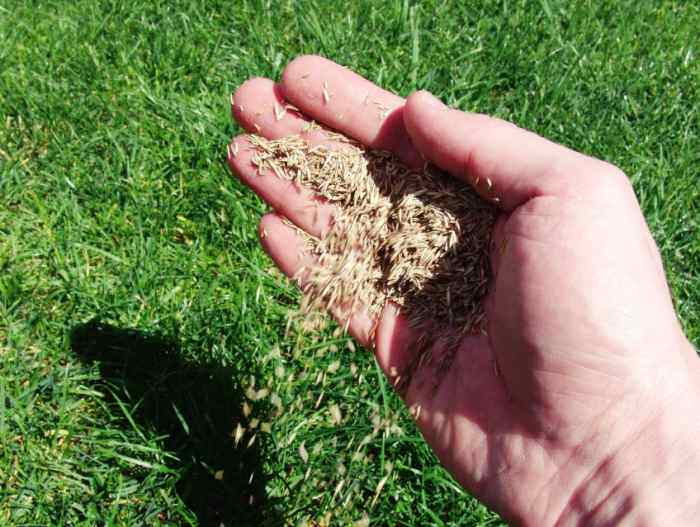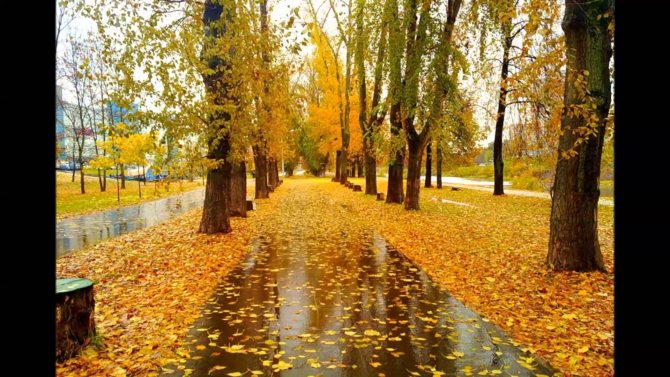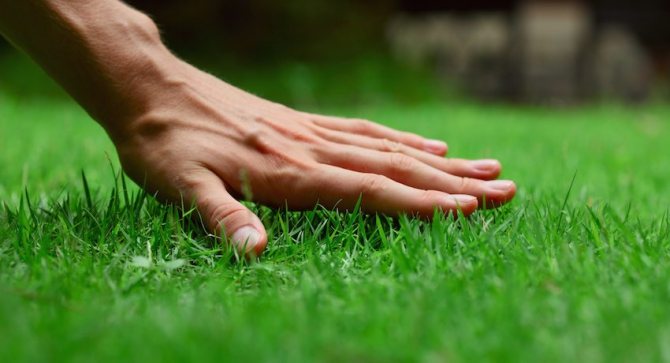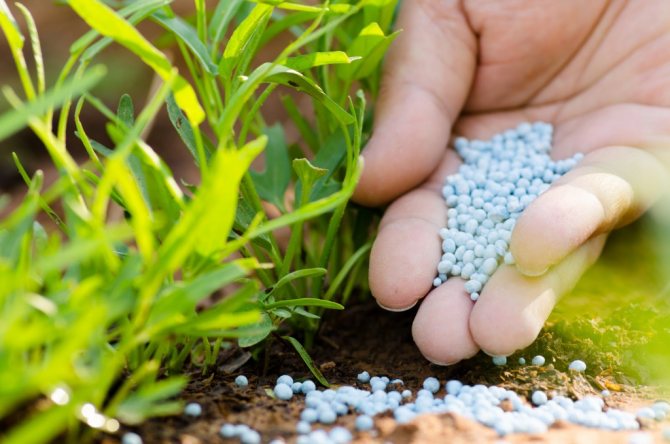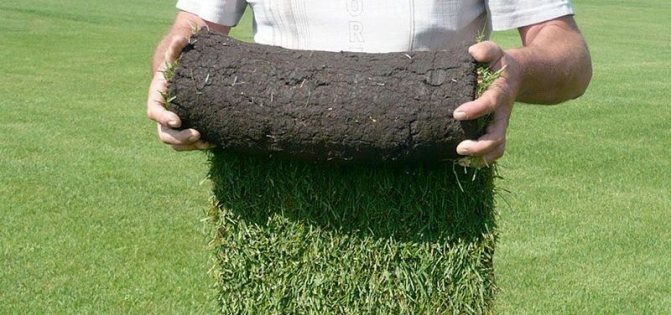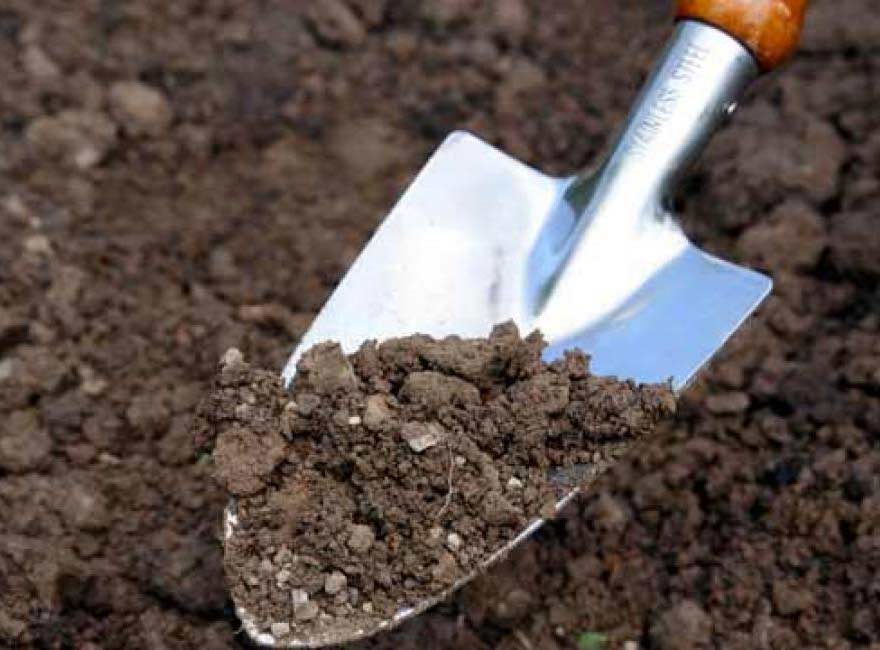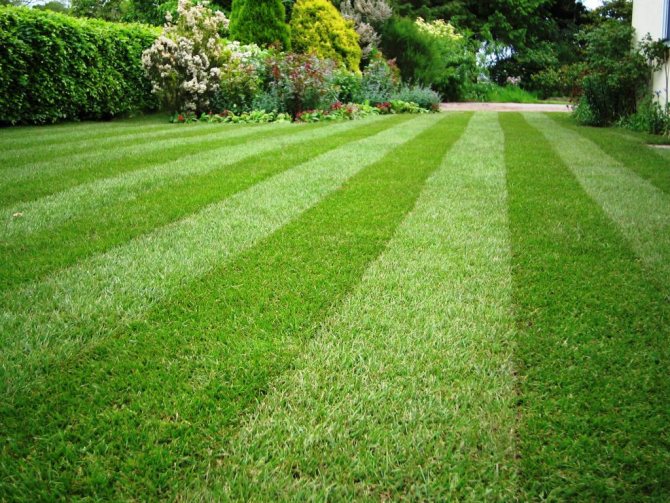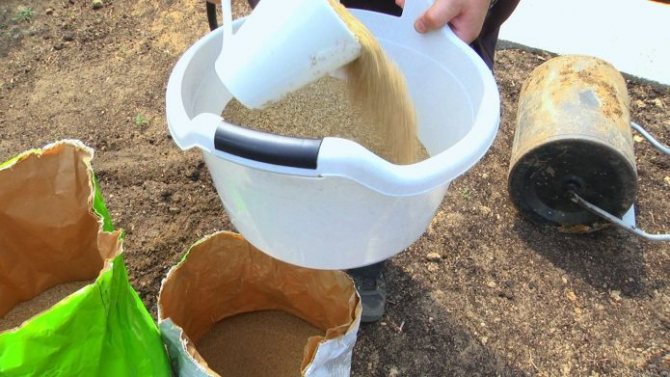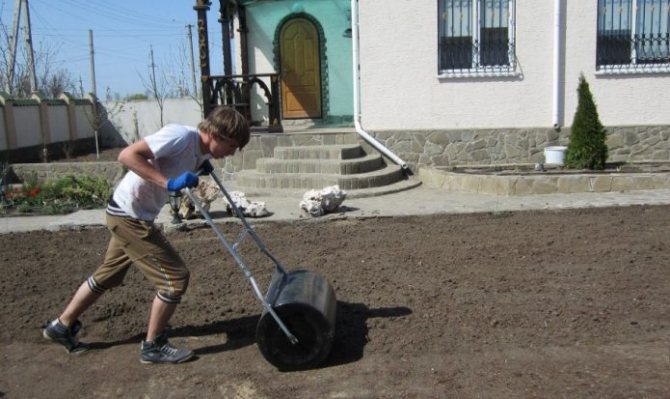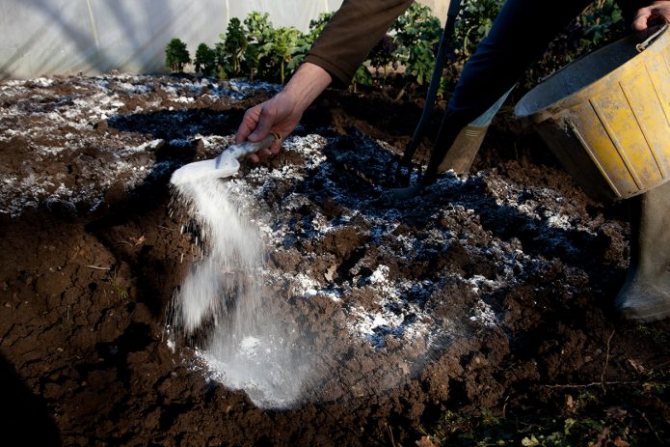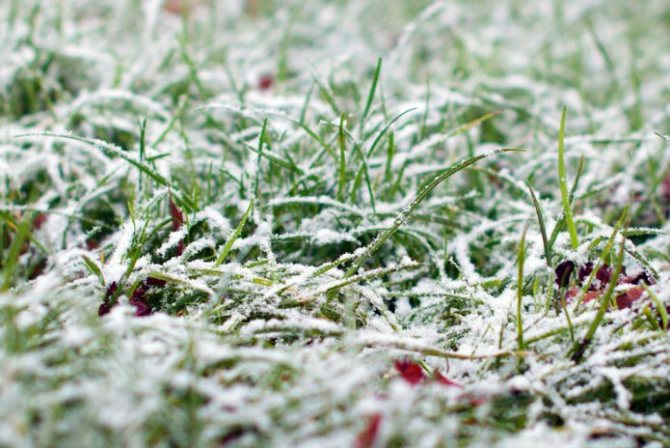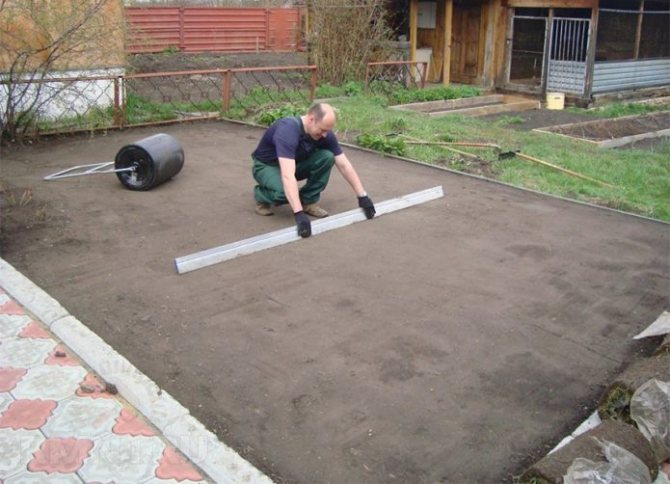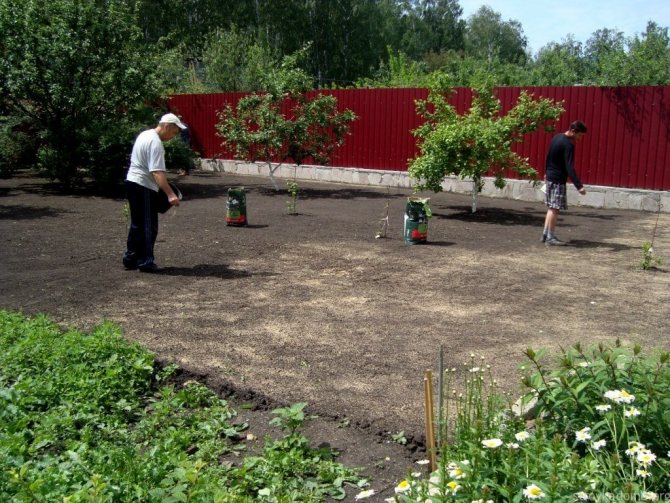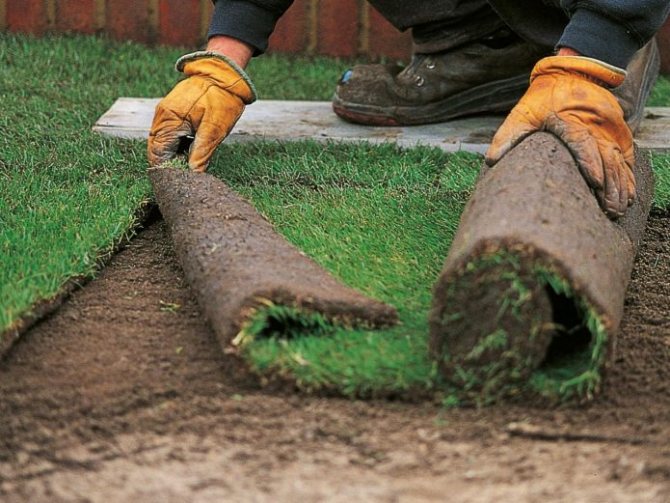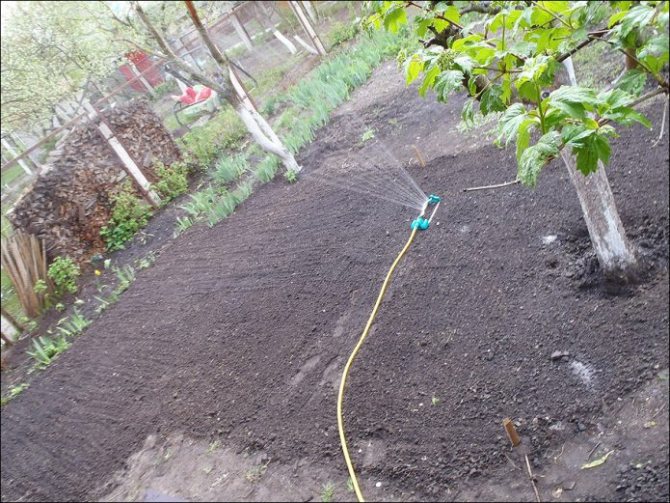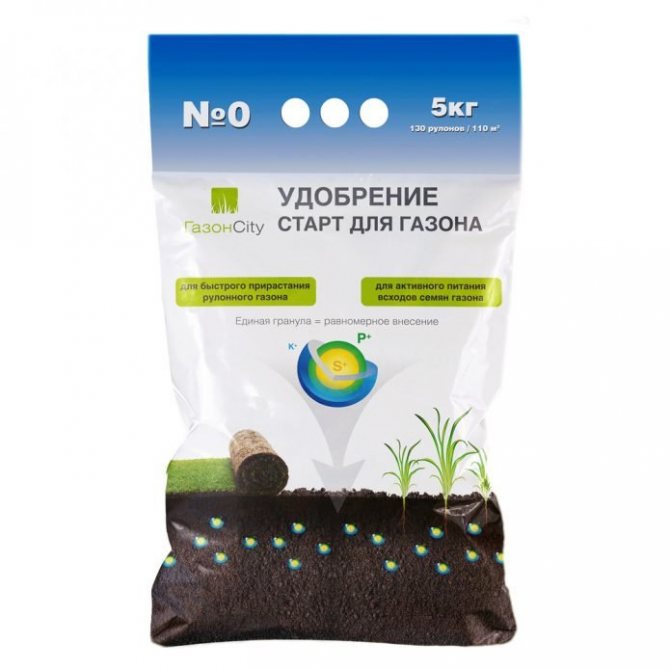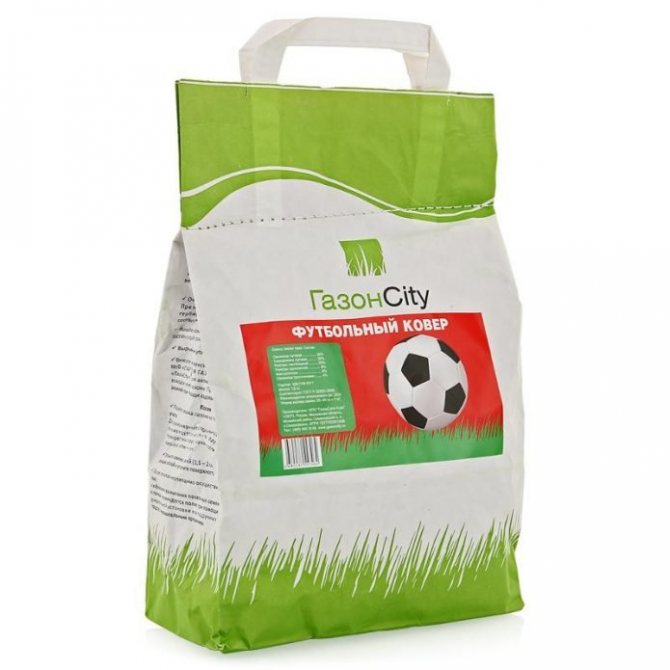A bright green lawn around the house will be an excellent decoration for any site in Kazan. Lawn grass - when to plant a lawn in the country, how to do it correctly?
When growing a lawn from grass seeds, the desired green carpet can only be obtained after two to three years, provided that all the rules for caring for grass sprouts are followed. Mistakes in maintenance or initially incorrect choice of grasses for the soil and climatic conditions of a particular site can lead to the fact that the lawn will be sparse, uneven, with bald patches and areas of yellowed grass.
When is it better to plant lawn grass: in spring or autumn
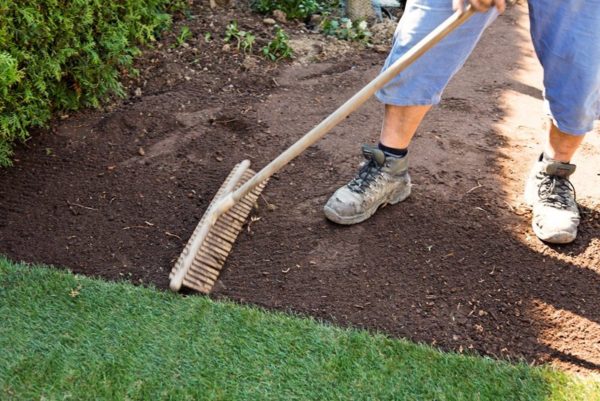
The choice of the right time for sowing lawn grass largely depends on the region, sowing material, soil condition, and their location. In addition, it should be borne in mind that crops in spring and summer require more careful care in the first days. Soil preparation, weed control, fertilization - there are differences depending on the season. But summer and spring shoots will delight right away, and autumn will have to wait until next year. If you sow the lawn in spring, then the first 2-3 weeks it is necessary to moisten the soil, and actively get rid of weeds. In the summer, it should not be allowed to dry out on hot days. Fertilizers with nitrogen are good to apply in the first spring months, for active growth and development.
In the fall, less watering will be required, the weed is no longer so active, the sprouts will have time to get stronger before frost. Some gardeners even plant in frozen ground, before the snow cover appears. In this case, the seeds undergo stratification, strengthening, and acquiring resistance to diseases. In the fall, it is better to fertilize with potassium and phosphorus; to strengthen the root system, much less nitrogen will be required at this time so that the seedlings can easily tolerate low temperatures.
Preparing a site for a lawn
As with all seeding operations, the site must be prepared before sowing lawn grass. The more carefully you do this, the easier it will be to care for your lawn later. Site preparation comes down to marking it, getting rid of weeds, digging and fertilizing the soil.
Sometimes bald patches appear on the lawn where you should replant. Before doing this, you must improve the area where this bald spot was created; to do this, apply mulch and lightly remove the soil with a hoe. The best times are in early spring or autumn; Avoid time too much heat or cold. You can use the work of the receiver to replace.
Read also Paint for a wooden table
In the spring, it is best to fertilize your lawn. In autumn and summer, to prepare it for temperature stress, it is better to use potash fertilizer, and for planting it is rich in phosphorus. The simplest is to use turf-specific fertilizers, which are usually slow-release solids, meaning they provide the nutrients you need over a period of weeks or months. Another option is to use mulch as fertilizer, which also improves soil structure and microbial activity.
Markup
When marking, it is necessary to take into account the site plan. It is necessary to determine where the flower beds, paths, gazebos, etc. will be located.
We remove weeds
After that, you need to start weed control.The site needs to be treated with herbicides, and especially stubborn weeds (spurge, burdock, etc.) should be re-treated after 2 weeks.
Alternatively, you can take advantage of the operation of the receiver after aeration to apply mulch. It is normal for any grass to develop weeds that spoil its appearance. To prevent its occurrence, often mow the meadow at the lowest altitude allowed by the planted sespitosis and season. This will deter many unwanted tenants, although you will have to pair them with tame weeds, especially if the area is small and the weeds are herbaceous or chemical by applying a broadleaf herbicide.
If moss appears in your meadow, good fertilization and regular scarification will help you reduce the problem. If, since it is a dark and damp area, moss persists, you may find it convenient to use an anti-moss product. Ask for advice at your garden center.
It is important to consider that spring grass is most susceptible to the effects of herbicides. Accordingly, this part of the preparation is best done in advance, around May, even if you then want to sow the lawn only in the fall. Since it is pointless to do this in the pre-winter time, since some of the ripened seeds can get into the soil, winter there safely and sprout in the spring, significantly complicating your work in the future.
Checking the table. These mushrooms set on the underside of leaves, indicating symptoms of exposure when they grow with longer stems than healthy ones, and if they are upside down, black or reddish-brown spots are observed that are spores of these fungi. No specific foods are known to prevent this disease, but it may help - until we can figure out what kind of fungus or fungus it is - sprinkle powdered sulfur early in the morning, spray, stick to the leaf.
This can be done every fifteen days until it freezes, since at low temperatures the intensity of the attack decreases. You can also eliminate elongated leaves that are symptoms of the disease. It is worty, from the same family as sweet potatoes and correlula. It can be planted both in autumn and spring. It is an excellent substitute for traditional grass as it usually forms soft and well-maturing mattresses throughout the year. It reproduces by seeds and then expands on stolons, which are stems that crawl along the ground and emit roots at every node, such as grass.
After the treated grass turns yellow and dries, it must be removed from the site, as well as cleaned of the remaining roots, stones and other debris, fill in the pits, and level the bumps.
Digging
After removing all the weeds, the soil must be carefully dug up. At the same time, weed control continues, by removing all encountered roots.
This seed is round, black and half the size of a soybean grain, with about 500 seeds weighing just under 500 grams. The seed whale covers approximately 80 square meters, and due to its imported origin, it is usually quite expensive for ordinary people, so it is advised to be very careful in its use. Although the bibliography says that in arid or semi-arid zones it is better to sow in the fall, because it is a species that needs a soil that is always moist, we must take into account that in turn they cause this disease, which can end with it, so what can be it is preferable to do this in the spring to avoid this disease.
Also, when digging, we get rid of stones, branches and other debris.
Despite the fact that the sowing of seeds will not be carried out deeply, it is necessary to dig up the plot to a depth of 20-25 cm. This is necessary so that the lawn grass could root well without encountering obstacles.


The soil should be well cultivated on a 20 cm surface. If you have it on hand, it is a good idea to add a generous dump of compost, as it is very hungry for humus and is otherwise covered with a mixture of 80% sand and 20% clay soil. Unsurprisingly, this look has become so popular with green coatings because its rich and velvety texture, bright green all year round, and the fact that they have the advantage of full sun or half shade in cold or warm climates is attested to.
It only requires abundant irrigation in areas with high sun exposure, making it ideal for all types of parks, gardens and areas with light shade. The main reason for almost all inquiries regarding this particular species is that it gives rise to the illusion that the garden owner will be relieved of the weekly cuts that require fescue or ryegrass lawns. There is a lot of controversy about whether the sun likes dichondra rather than medium shade and little or heavy watering. In that sense, there will be many people who will tell me that they have seen them grow very well in places with little irrigation, which is absolutely true.
The area for the lawn must be well dug
Fertilization
If necessary, fertilize the soil during digging. The choice of fertilizer depends on the composition of the soil, the sowing time and even the type of grass to be sown.
So, slaked lime is added to acidic soil (ordinary chalk is also perfect), to clayey - humus, etc.
If sowing is carried out in the spring, then the emphasis should be on nitrogen fertilizers: they contribute to the rapid growth of grass. A lawn planted in autumn needs large quantities of potassium and phosphorus: they will strengthen the root system of a young lawn and help it survive the winter painlessly.
After all the measures described, the site is left alone for about a week, so that the soil "matures". If during this time new weeds have appeared, they must be weeded out by hand - herbicides can no longer be used.
Benefits of autumn sowing
Each season has its own pros and cons for planting lawn grass. Each gardener chooses his time, analyzing all the possibilities and advantages for himself. Autumn planting is preferable for a number of reasons:
- lack of heat, which allows you to pay less attention to watering, has a beneficial effect on seed germination;
- soil and air moisture without sharp fluctuations;
- weeds are no longer growing as actively as in spring;
- shoots sprout in a dense layer and grow higher;
- the root system is formed stronger, and the grass is resistant to diseases;
- the soil does not require long preparations.
Care rules
- Within a month after sowing the planting material, it should be protected from the sun, excess moisture, wind.
- A mosquito net is used for this, which must be pulled over the pegs.
- When planting in spring, it is left for the entire summer season.
- Autumn crops should not be covered, as they have already hardened in the open field in winter.
- In the first year of life, the grass should not be loaded, it should be given the opportunity to take root in the root system.
- Remove the weed periodically.
- It is correct to do the first haircut, namely: only one cm of grass is sheared.
- Further, the tonsure will be regular, but in each case only a third of the stem is cut off.
Features of autumn planting of a lawn


In the spring, before planting, it is necessary to clear the lawn of debris, apply fertilizers, and then let the ground stay “under steam” for at least 40 days. Sometimes it takes a lot of time, which is more important to spend on planting vegetables, herbs, pruning shrubs and trees. Seeds planted in autumn, with the arrival of spring, will not require complex care, but with the onset of warm weather they will quickly begin to delight with their greenery. During the fall and winter, the sprouts form a strong root system, which only emerged weeds cannot greatly affect.
If the winters in the region are harsh, you will have to cover the lawn with peat, spruce branches to insulate it. Autumn seedlings are difficult to correct if they sprout unevenly, because there is no time to correct it. In this case, already in the spring you will have to finish sowing or remodel completely. Seed selection must be more careful so that varieties can survive the winter without dying. In areas with a slope in the fall, it is better not to plant lawn grass, because when the snow melts, the spring melt water washes the seeds out of the soil.
How to prepare the soil for planting?


You can't just buy grass seeds and plant them on the site. The soil for the future lawn must be well prepared so that the seeds take root and give abundant shoots:
- It is necessary to remove any debris from the territory of the future lawn. Some gardeners do not remove natural debris - stones, branches, fallen leaves - but bury it for a "natural ecosystem". This is a gross mistake. Debris should be removed from the site.
- Uproot old tree stumps, if any. They will not decorate your future lawn, and the large and rough roots of the stumps will interfere with the development of the root system of the lawn.
- Treat the area with herbicides to remove weeds.
- Dig up the territory of the future lawn. At the same time, create a drainage layer of their rubble and apply organic fertilizers.
- Level the soil surface thoroughly. There should be no bumps or depressions on the lawn, otherwise the water will be unevenly distributed, which will lead to damping in some places and yellowing in others.
- Compact the soil with a roller and then loosen the topsoil with a rake.
Only after completing all these manipulations will the soil in your area be ready to receive grass seeds. Neglecting any of these steps can lead to uneven seed germination. But immediately after the completion of the work, it is also impossible to sow grass. The prepared area should be left "under steam" for one to two months. It is recommended to devote this time to studying the features of lawn grasses and compiling a suitable grass mixture for your site, taking into account its agrotechnical features.
Step-by-step instructions for sowing a lawn in autumn
After building a house and improving the local area, you can devote time to the lawn. For the process to be successful, and in spring the green cover pleases the eye, it is necessary to take into account the rules that will make this process easier and more effective. The selection of seeds, preparation of soil, fertilizers are important stages, the observance of which will allow you to decorate the site for a long time.
Dates of autumn planting
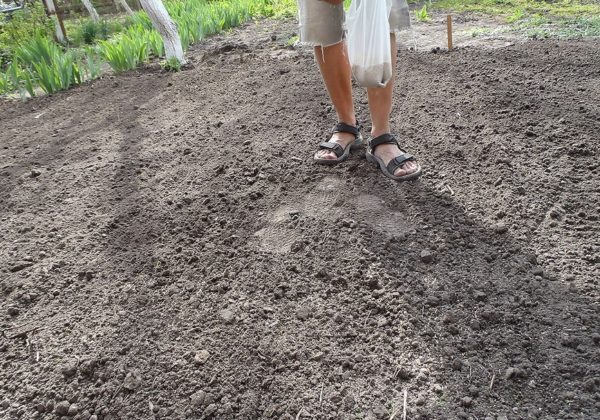

In the fall, it is possible to sow seeds twice - in late August, early September, or in October, early November. In the first case, it is important to take into account that at least 40-45 days must elapse between the landing period and the onset of frost. In this case, a strong root system will have time to form, and the aerial part will grow up to 10 cm. Sudden night frosts can destroy crops, so it is better not to postpone this process, starting a little earlier.
Before winter, sowing in late October, early November, it is possible even in frozen soil. In this case, the seeds will undergo a natural process of stratification, which makes it possible to grow active and friendly seedlings in the spring. So that the seed does not die, it is worth considering the planting time when choosing grass varieties. There are also risks - if, after sowing, warm weather suddenly returns with temperatures above + 5 ° C, the germination period will begin, as a result of which the seedlings will die from the cold.
Site preparation
Before sowing, the land must be properly prepared so that as a result, a beautiful green carpet flaunts in front of the house. The first step is to completely clear the area of everything that might interfere:
- construction garbage;
- stones that cannot be entered as an addition or an island;
- branches;
- old stumps;
- dry bushes, trees.
On a site where nothing has been planted for a long time, or is being cultivated for the first time, it is better to treat the soil with herbicides. Then, when sprouting, minimal weeding is required.
When the place is cleared, processed, it is necessary to start digging in order to remove the small roots of plants, the remaining debris. It is better to lighten clayey viscous soil - for this, fine gravel or sand is introduced, then aeration will be better. Compost or humus is added to the sandy soil. For good growth of lawn grasses, the optimum acidity is 5.5-7 pH, if it is higher, liming is carried out with lime or dolomite flour.
How to plant a lawn in the fall: steps and rules
Creating a lawn is a process with several important steps, so it is recommended to carefully plan it.
Soil quality
Soil preparation is a fundamental task and should not be underestimated. How to carry it out? The grass needs a well-permeable subsoil and sandy-clay soil 20-30 centimeters thick. The optimum acidity is pH 5.5-7.0. The grass does not like extreme conditions - neither too wet “base”, nor too dry. Excessive moisture will promote the formation of moss, and excessive dryness will dry out the plants.
The soil structure and pH level can be adjusted. So, if the soil is clay, it is worth adding gravel with a fraction of 0-4 mm in order to improve the air-water regime in the soil and allow the roots to grow freely and strongly. In the case of weak, sandy soils, you can add compost or the right amount of peat to increase the humus content. In the case of a low pH level, liming is necessary, which increases the acidity of the soil to a more alkaline one and creates the desired structure of soil lumpiness. Liming also prevents moss from growing.
Preparation of the base
- The place chosen for a brand new lawn must be cleared of stones, leaves, weeds and other plants. This is a very important preparatory step when creating a lawn around a newly built home - it is worth taking the time to remove debris after construction work. Careless cleaning of the base will result in yellowing and wilting of the turf.
- Then it needs to be dug up, that is, loosened, filled with air. It is also a good time to correct the soil structure if necessary, and to increase the phosphorus and potassium levels by adding the appropriate fertilizer.
The most convenient way to perform these procedures is to use a rotary tiller that is adapted to the size of the lawn area. It allows for efficient, simple and fast gardening that requires physical effort.
- The next step is to level the grooves and level the surface, after which the area should be evenly hydrated.
Watering the territory
This step will better stabilize the soil. After a period of drought, the procedure can have an additional positive effect - it will provide better moisture to the deeper layers of the earth and create more favorable conditions for the grass for development, as well as limit the flow of seeds during a possible rainstorm.
In the case of automatic irrigation, there is no need to water the land before sowing.
After watering, it is worth waiting for the soil to dry out on top and rolling.
Sowing seeds or laying turf from a roll
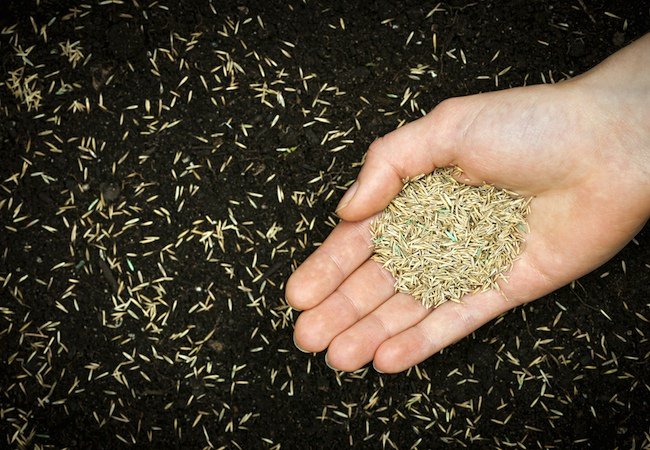

The penultimate stage of planting a lawn in the fall with your own hands is sowing or laying out turf rolls. The strips with ready-made grass should be laid tightly to each other, pressing them well to the soil and constantly maintaining the same direction of plant growth (all should be either "along the coat" or "against the coat"). After a few days, the roots will grow back into the ground.
Sowing grass is a cheaper way to implement, but intended for more patient people. The germination and growth time of the turf depends on the type of grass, therefore the correct selection of the seed composition is very important.If the aesthetics of the appearance of the lawn and the convenience of caring for it in the future are important to you, it is better to use mixtures with a predominance of fescue. They grow slower and have smaller leaves, but they do not tolerate intensive use of the site worse.
It is best to choose mixtures from well-known manufacturers. You should not be guided by price alone, as cheap options carry the risk of a low germination percentage. The end result can be disappointing, and besides, the herb tends to be weak and prone to disease, and it takes a lot of effort to care for it later.
The grass is sown manually or mechanically, in the quantities recommended on the package. Then the seeds are raked up, covered with a thin layer of soil, and rolled in order to level the surface and press the seeds.
Watering
The last and key step in creating a lawn is watering - seeds and sod in rolls. During the first days, the soil in which the seeds germinate and the plants form the root system must be constantly moist. This is especially important in dry years and, mainly, during the period when plants sprout. It is recommended to water them up to four to five times throughout the day to keep the seedlings from drying out. At the same time, it is necessary to irrigate the site with small drops so that too powerful a stream of water does not wash away the seeds. Then you should gradually reduce the intensity of watering to once a day. Thus, soil moisture is ensured - together with the night air and morning dew, this will create favorable conditions for seed germination and plant rooting.
Mowing
When the blades of grass reach a height of about 8 cm, the first mowing should be carried out - a little higher than 5-6 cm. Since the leaves are young and tender, you need to do this carefully to avoid pulling them out.
The lawn from a roll should be mowed for the first time 2-3 weeks after laying, when the plants grow up to 5-7 cm.
Thus, the question of whether lawns are planted in autumn provides a positive answer. The grass cover on the site can even turn out better than sown "when it should be" - in the spring. The main thing is that the weather does not let down and that the planting of the lawn in the fall is carried out according to certain rules.
Lawn planting rules


For those who find it difficult to comply with all the rules for soil preparation and planting, or there is no time, it is better to purchase ready-made lawn rolls. In nurseries, a sod layer is bred, then its upper part is cut off, together with the already formed cover, it is rolled up for transportation into rolls. After that, it is enough to lay it on the prepared ground so that it takes root in a new place. The soil is prepared in the same way as for seeds.
A roll lawn is convenient for embossed and shaded areas. Planting the seeds evenly and waiting for an even cover in such places is quite difficult and long, the finished sod layer is brought already cut, with top dressing, without weeds. But it is important not to delay planting and lay it no later than the next day after cutting.
Before laying the lawn, make sure that the area is clear of debris, unnecessary stumps, branches. For poor soils, you will need to add a layer of black soil on top, fertilizers are applied a week before the start of laying. When everything is laid, you need to water abundantly, repeating this every day for two weeks, then moisturizing is carried out as needed. After 10 days, you can start trimming.
Seat selection
Sowing lawn grass begins with site selection. Grass mixtures can be planted almost anywhere on your site. Will fit:
- horizontal surface;
- the sun;
- shadow;
- slopes;
- clay and sandy soils.
In each specific case, only the amount of physical and material effort required to plant and grow a beautiful and green lawn will differ. Grass mixtures are best planted in a sunny place where rain and melt water will not stagnate.
Before you start sowing seeds, it is advisable to think over the scheme of the future lawn and even sketch it. It will be necessary to decide whether to leave trees on the site, grow individual flowers or arrange flower beds. It is necessary to decide in advance on the placement of landscape design elements, because difficulties may arise with cutting the grown lawn grass.
If a lawn mower is to be used, then when sowing the grass, you can leave a distance of one meter between it and fences, walls or curbs for convenience. In addition, you should not plant under a lonely bush or tree.
Tools needed for planting and grooming
For soil preparation, sowing and further care, gardeners will need tools to help keep the lawn in perfect condition:
- rake (metal or wooden);
- roller or other device for compaction of soil;
- several slats made of wood (1 m long);
- mosquito net (protects seeds from direct sunlight);
- complex fertilizers (for every square meter - 50 g);
- a watering can with a spray (it is better that the holes are small);
- aerator;
- scales for weighing seeds, herbicides or fertilizers.
The main tool, perhaps, are seeds - they must be carefully selected from trusted sellers.
Planting in spring
- Preparation for spring planting begins in the fall.
- The landing site is determined. The site must be well consecrated.
- The land is dug up, treated with herbicides, nitrogen fertilizers.
- The soil is loosened with a rake.
- Sowing begins in mid-spring.
- Seeds are sown in the ground and compacted with a roller. This procedure prevents their weathering.
- Seedlings will appear in a few weeks.
- As soon as the seedlings reach 18 cm, the first haircut is carried out, only in dry weather.
- Until the onset of winter, there will be a viable and strengthened lawn.
Minuses
- Tremendous efforts are made to maintain the lawn throughout the season: pest control, weed removal, correction of individual zones, mowing.
- In the southern regions, early summer and young seedlings are exposed to sunlight. If this is a small area, it can be covered; with more powerful areas, it will be difficult to do this.
- Soil preparation is more troublesome.
- Herbicides are applied when there are weeds, in the empty land, they do not rush, so their waiting time is delayed.
- 30 days before sowing, the land is fallow. Let's say the spring is cold, then the whole process will take place with unheated soil.
- Weeds grow profusely, weeding will have to be done regularly.
Winter lawn. November sowing of lawn grasses before winter. 3 tips.
Late fall. The rooks flew away. The forest was bare, the fields were empty. Nature is tired of giving birth and has entered the resting stage of natural menopause. Those who did not have time to complete the construction of country cottages became sad that again they could not beautify their site in this garden season. Experienced gardeners know one nuance that allows you to violate the established deadlines for creating a lawn. Sometimes it is even preferable to sow the lawn "under the snow".
1. Don't miss the garden season
According to the established gardening rules, roll lawns are best laid before July 15, and sown ones - before September 15. Then the rolls grow well to the mother soil, and the young blades of grass that have grown from seeds have time to take root and harden well. But there are exceptions to all the rules!
2. Join the Divine Providence personally. The creator was the first gardener. Therefore, throw at least one handful of seeds with your generous hand. Remember the words from the first book of Moses. BEING. And God said: “Let the earth grow green, grass that sows seed, a fruitful tree that bears fruit after its kind, in which is its seed on the earth. And it became so + And God saw that it was good. "
3.Even your mother-in-law will love you. When performing a sacrament, observe conspiracy - making surprises for loved ones! Imagine what a surprised face your friend will have, confident that you yourself cannot choose two identical socks from a heap of washed ones, and suddenly she sees bright green sprouts of the future magnificent lawn on the "eternal" construction site, which you have grown and laid at her feet. Believe me, your rating will increase not only in the eyes of your beloved, even your mother-in-law will look at you with great respect!
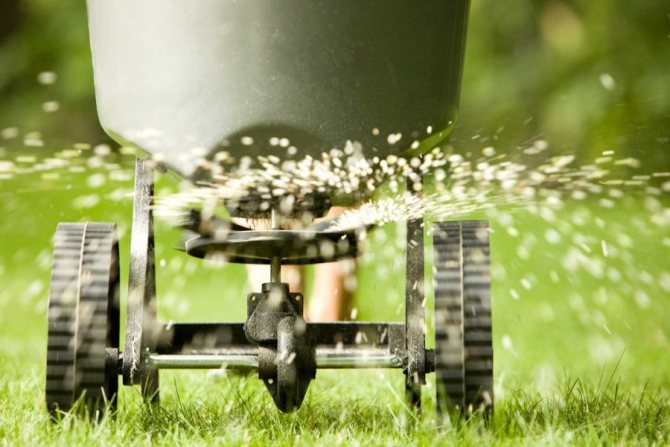

We are used to the fact that most crops need to be sown in the spring. Everything around is blooming and smelling, nature comes to life, which means it's time to start field work. But it was not there! It turns out that planting grass at the end of October is no less, and in some cases even more profitable than spring sowing. Why this happens and when you need to sow lawn grass before winter, you will find out in an article specially prepared for the readers of the site.
- Why is winter sowing of the lawn preferable?
- Preparing the lawn for sowing: where to start?
- We also recommend reading
- Sowing a lawn in winter: let's get started!
- How to care for your autumn lawn?
Show all content
When is the best time to sow your lawn?
Considering 2 options for planting seeds, you can see that there are some factors on which the planting time depends:
- Climatic conditions of an individual region.
- Complete soil preparation.
- The choice of the variety.
- Care options.
If you are thinking of decorating the area around the house and in the garden with a lawn, then the fastest way is to spread a roll lawn. You will save your time, but the cost of a rolled lawn will be several times higher than the cost of a sown lawn, especially if it is not properly laid, many unpleasant problems will arise.
"Sowing a lawn with seeds is not difficult, it turns out to be as fluffy and green as a rolled lawn, but you will spend much less money and effort." The future lawn owner has a question: when is it wiser to plant a lawn, at what time of the year? Experts note that grass seeds are capable of sprouting from spring to the very frost. Different periods of grass germination have their own characteristics.
- The lawn, if it was sown before winter, runs the risk of freezing in severe frosts or crushing under a thick layer of snow.
- Summer sowing of lawn grass gives quick results, but requires careful and regular maintenance, especially watering.
- Spring crops most closely match the natural rhythm and are close to the natural growth of grasses. The soil is already warm enough in spring, and after winter there is enough moisture in it for shoots of lawn grass. The lawn rises more magnificently and amicably in the spring.
We suggest you familiarize yourself with: Lemon and garlic for memory
Why is winter sowing of the lawn preferable?
Agronomists and agricultural experts agreed that planting lawn grass before winter is much preferable. As evidence, they cite the following "iron" arguments:
- The air and soil have a fairly high humidity.
- It has not yet had time to get cold, so the temperature for seed germination remains optimal.
- Weeds hardly grow at this time.
As you can see, the conditions for good shoot formation and the formation of strong roots are more than favorable. For example, if a lawn is sown in the winter in September, it will have time to grow up to 8-10 centimeters by the first frost.


The sown lawn in September will have time to root well and germinate before winter
How to calculate the number of seeds?
To calculate the sowing of a mixture of herbs for a certain type of herbs that are included in its composition, a special formula is used, and the results are summed up. The seeding rate of seeds (kg / ha) must be multiplied by the percentage of the amount of this species in the mixture and divided by the actual suitability of the seeds. As practice shows, in order to sow lawn grass efficiently, it is necessary to increase the consumption of seeds by 2 - 3 times.
If only one type of grass is to be sown, then the seeding rate of the selected crop must be followed. On average, the consumption of seeds of lawn grass per 1 m2 is 30 - 50 grams.
Preparing the lawn for sowing: where to start?
The worst time to plant grass is in the summer months.
At this time, the seeds have a very low germination rate. If you plan on sowing lawn grass before winter, be sure to treat the soil well before sowing. Much depends on the size and location of the site. If you plan to plant a lawn in lowlands before winter, the land will accumulate water much more. This will not affect the quality of the grass in the best way.
To avoid poor growth, we advise you to immediately lay good, high-quality drainage. Use gravel or sand as the base material. After that, you can proceed to laying the soil. This option is especially preferable if a sports-type lawn is planned. The territory is cleared for crops, garbage is removed, and the soil is leveled. As for the land, it must be cleared of all, even the smallest weeds, roots, and some other plants.
The problem of areas with a decent slope is solved by hydroseeding. Melt water will not be able to harm the seeds if the planting was done in a "cunning" way. It even has an official name - hydroseeding. By the way, for sowing large areas, it is also effective. A special mixture is prepared from seeds, technological additives with gluing functions, fertilizers and water. This whole set is driven into the ground under a fairly powerful pressure of 6 atmospheres. Thanks to this, as well as the adhering substances, the seeds adhere perfectly even on steep slopes.
Lawn Seed Selection
An equally important issue is the choice of herbal mixture. After all, it should not only correspond to the type of lawn you have chosen (sports, parterre, etc.), but also be maximally adapted to the climatic features in your area.
For effective use of water in hot weather during the central hours of the day, water is not recommended to avoid loss by evaporation, as well as to protect the leaves from burns and, above all, from diseases. Remember that more abundant and more spaced irrigation promotes deeper roots and therefore greater drought tolerance.
Over time, the grass becomes compact, preventing the roots from growing in optimal conditions and getting the water they need. This problem is exacerbated when the ground is clayey. The aerated person's job is to try to compensate for the compaction by removing small pieces from the ground as if it were a shock.
For example, a mixture imported from Europe, where the climate is milder, may not survive our harsh winter. The most suitable in this regard are red fescue, field bent and meadow bluegrass. Therefore, when choosing a mixture, give preference to the one in which these herbs predominate.
An important condition is the ability of grasses to reproduce vegetatively, since regular mowing of the lawn grass excludes the possibility of seeds ripening, and the prospect of sowing the lawn again every year is unlikely to please anyone.
It consists of applying a small layer of sand, mulch, or a mixture of both on the lawn. This work is especially evident after aeration, because the holes are filled with new, looser substrate, which will facilitate root elongation and improve the quality of the turf.
On many lawns, a layer of plant debris, moss, and soil builds up at the base of the grass, which protects the soil from soil and encourages the growth of fungi and pests. To eliminate this mattress, you must scarify, that is, scratch the surface of the ground. You can use a rake on small surfaces or a scarifier on large meadows. The frequency of scarification will depend on climate and terrain orientation.In darker and wetter areas, you should do this more often, up to once a year, but in more comfortable lawns, you should not need to do this work after a few years.
As for the number of seeds, do not forget that their consumption per 1 m 2 of the plot is approximately 50 grams.


Choose grass seeds for your lawn that can reproduce vegetatively
Sowing a lawn in winter: let's get started!
The expression "in winter" does not mean at all that you stubbornly wait for the first snow and only after that start planting seeds. It is better to carry out this procedure in early autumn, when the ground is no longer dry, but the risk of seeds freezing is minimal. If sowing is done later, your lawn will not have time to mature and may not be able to withstand the coming winter.
Sowing a lawn in winter is always carried out on a quiet and calm day. This is a necessary measure so that the lawn is uniform and the seeds do not scatter. After that, they are sprinkled with peat about 8-10 centimeters, the area is leveled with a lawn roller. Everything is done as quickly and efficiently as possible. The quality of your lawn in the future will depend on this.


Leveling the soil with a lawn roller
The temperature should not be below zero. It is highly desirable that no more than 40 days pass from the moment of sowing to the onset of the first frost. The root system will have time to get stronger, the grass will be able to grow to the desired height.
However, sowing a lawn on frozen ground before winter also has its fans. They have their own arguments. They say that in autumn the weather is too unpredictable, frosts can hit in September-October. It is best to do this in slightly frozen ground until a sufficiently dense snow cover appears.
With the correct timing, this sowing method also has a right to exist. The grass begins to grow literally before our eyes, light permafrost only hardens the seeds, gives them additional strength. Excellent seedlings can be expected in early spring. The melted snow immediately impregnates the soil with the necessary moisture to feed the grass. Plants acquire good frost and moisture resistance. They are much less susceptible to diseases, pests and weeds.
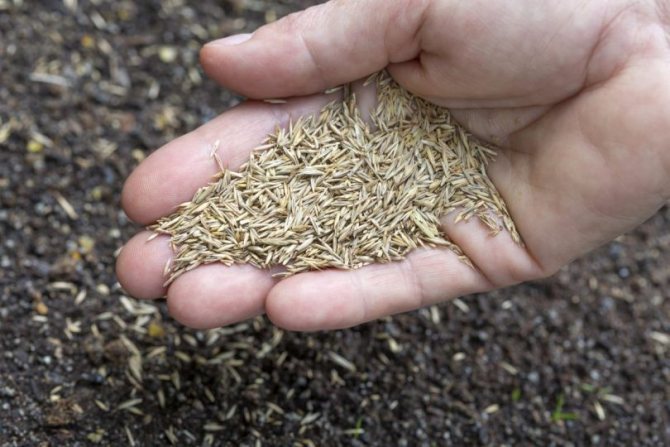

Lawn seeds can also be sown in slightly frozen ground
On the other hand, sowing a lawn before winter is unlikely to be suitable for people whose plots are at a slight slope. In early spring, the snow begins to melt and simply washes out the soil along with the seeds it contains. However, such crops are risky for another reason. In autumn, the air temperature is really changeable. After frosts in September, there may be a sharp warming in October. The temperature immediately rises, the seeds grow, and with subsequent frosts, alas, they freeze and die. Sowing lawn grass in the fall in winter is not effective, and in the spring it has to be redone. When choosing seeds, buy those that have increased frost resistance. This significantly reduces the potential risks.
Planting seeds of the future lawn
This stage is one of the most important, the correct planting largely determines the appearance of the future lawn. For planting work it is necessary to prepare:
- Seeds of selected herbs;
- Mineral fertilizers;
- Territory measurement tape;
- Garden rake;
- Watering can or hose with spray nozzle;
- Seed spreader (you can do without it).


On the day chosen for planting the lawn, the weather should be dry and calm so that the seeds are not flooded with water and carried away by gusts of wind. Before sowing, it is necessary to apply mineral fertilizers and once again loosen the soil with a garden rake.
You can find advice in some gardening magazines to mix grass seeds with sand when planting. However, we do not recommend doing this. You can take more sand than you need and it will prevent the seeds from germinating.
For even seeding, you can use a special seeder, but theoretically it is possible to achieve even seeding by hand. To do this, spread half of the seeds in one direction and the other half in a direction perpendicular to it.
Once seeding is complete, take your garden rake again and very gently mix the soil with the seeds. Ideally, all seeds should go 2-3 mm into the soil, but in practice some of them will remain on the surface. Water your crops gently.
If done correctly, you will see the first shoots in 1-2 weeks. Throughout this time, it is necessary to water the crops every day so that the soil is not dry. But make sure that the water does not erode the ground.
How to care for your autumn lawn?
So, you already know when to plant lawn grass, and perhaps even managed to sow. In this case, try to keep the lawn in top condition. Subsequently, the grass will begin to grow, the weeds will also make themselves felt. This also applies to other pests. That is why it is so important to follow all the rules for caring for the site:
- Regular watering. Can seeds planted in autumn be watered? It is not only possible, but also necessary! Regular watering will determine the strength and beauty of your lawn. But you shouldn't overdo it either. The advantages and features of autumn are such that rainy weather always prevails in this season. Therefore, you are unlikely to need to water the ground too often.
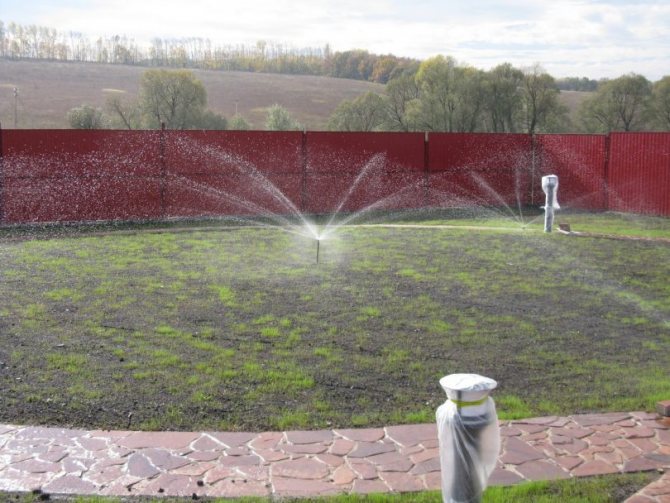

The strength and beauty of your lawn will depend on regular watering.
- Quality fertilizers. Surely, you would like the sprouted grass to have a beautiful green color. Nothing complicated! Apply fertilizers and minerals in a timely manner, make the necessary top dressing. Humus is best suited for these purposes. Taking too fresh is not recommended. The best option is humus at the age of 1-2 years. Within a week you will see the result of the work done.
- Pruning. Even in the fall, a month before the snow falls, one should not forget about the appearance of the lawn. The grass grows by leaps and bounds. Soon its height reaches unprecedented proportions. If you plan to grow a real mini-forest in front of the house, you can leave it unattended. As practice shows, only a few do this, but most other farmers still monitor the size of green spaces and take measures in time. By the way, you don't have to mow it. You can always act in an original way and cut out some intricate drawings or shapes. This trend is very common today.


The grass grows by leaps and bounds if you mow it regularly
- Remember to take care of the health of your lawn. First of all, care is shown in the fight against weeds and various pests. The weed issue is easy to solve. You can remove them by hand or add special substances to the ground in advance to prevent their growth. It is much more difficult to eradicate slugs and shrews, although there are many poisons to eliminate them.
As for the choice of the mixture, 5-7 different herbs in the composition will be the best option.


Optimally, choose several types of grass
Of course, this is not the whole list of activities aimed at caring for the autumn-winter lawn. It can be concluded that sowing a lawn for the winter is not a difficult task in itself. In addition, if you approach the solution of this issue with all responsibility and seriousness, problems will definitely not arise. But do not forget that the final result always depends on the highest quality implementation of each stage.
Seedling care
How to properly sow lawn grass with your own hands
The main part of lawn care activities involves the implementation of:
- glaze;
- cleaning;
- top dressing;
- cutting.
All these procedures are simple to perform, but they must be repeated regularly, otherwise the appearance of the lawn will noticeably deteriorate.
In winter, it is not recommended:
- walk on the lawn if the snow cover is less than 20 cm thick;
- arrange a skating rink on the lawn area;
- cover the lawn with snow;
In the spring, the following actions are required:
- to clear the area from debris, stones and leaves;
- comb the lawn with a fan rake;
- aerate and fertilize the soil;
- treat plants for fungal diseases by spraying them with fungicides;
- sow those areas that have remained bare;
- cut the lawn.
In the summer, the list is reduced to watering (done every two days), fertilizing and clipping. With the onset of autumn, it will be necessary to sow the bare areas, fertilize the soil and aerate it.
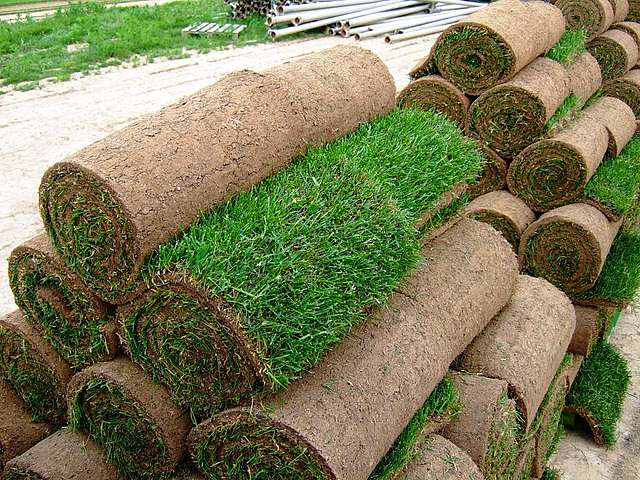

Rolled lawns
Lawn grass planting technology
In order to ultimately get a beautiful lawn, you should take into account the basic recommendations for the correct sowing of grass:
- You can sow by hand or use a special seeder. This should be done only on a dry and calm day, then the seeds will not be blown away by the wind.
- If the soil is dry, it needs to be watered and loosened. On the package with seeds, it is indicated how many seeds are needed per square meter, and be guided by these indicators.
- If you decide to sow yourself, you should not throw the seeds further away from you, so the larger ones will fly off to the periphery, and the crayons will crumble under your feet. As a result, the seeds will be unevenly distributed, and the lawn will turn out to be clumpy.
- Sow the nearest meters in front of you and move on. Do not try to add seeds to the bald patches, because this way you will definitely add them.
- It is better to walk over the entire section, but in a direction perpendicular to the first.
- The next step is to rake the entire area with a fan rake to sprinkle the seeds with a small layer of soil.
- Do not use a watering can with a large spray, otherwise you will simply wash out the entire lawn. / Li>
The most important thing in care is abundant watering. This will allow the grass to grow thick and have a well-developed root system.
The first shoots will appear after about two weeks of proper care. However, it all depends on the type of herbs you planted.
If the lawn is watered correctly, it will be possible to mow it for the first time in two weeks. But until that time, it is better not to let the animals go there and not to walk on our own.
After the first mowing, further care should include timely fertilization and weekly mowing. In the fall, it is useful to mulch the lawn.
So, as you can see from the text, the rules for planting and growing a lawn are not so complicated. If you follow them, your area will always have a fresh emerald lawn carpet that will please the eye.
How to sow a lawn in the country
A week or two after fertilization, you can proceed directly to sowing the lawn. To do this, choose a dry, calm day so that the seeds are not blown away by the wind.
- Water the area thoroughly the day before planting. Use a spray gun to prevent the water jet from leaving dents on the level ground.
- Mix seeds with dry sand. This will help distribute them more evenly throughout the area.
- Scatter them over the prepared area. This should be done in two directions: first, for example, along the lawn, and then across.
- Rake the seeds carefully into the ground. Distribute them also first in one direction, and then in a direction perpendicular to the first.
- Next comes, perhaps, the most difficult and very important stage of the work. You need to compact the soil loosened with a rake. This is necessary, firstly, so that the seeds are pressed to the soil and are not carried away by the wind. And secondly, the compaction of the earth will make the lawn even, without bumps and pits.
It is good if you have a special skating rink for this purpose - then the work will not be difficult. However, most summer residents who are going to equip one small lawn on the site do not have such a device. This means that we will have to use what we have.
- You can put skis on your feet and “pass” them through the entire lawn.
- You can nail old shoes to wooden planks and tamp the soil in this way.
- Or you can just walk the entire area far and wide and compact the soil with your feet.
Further care of the sown lawn consists in regular watering. If the weather is dry, then the first three weeks the site needs to be watered every other day. A prerequisite is the presence of a sprinkler or watering with a watering can with small holes.
After two to three weeks, the first shoots will appear, and the amount of watering can be reduced. Here, attention needs to be shifted to weeds. All excess plants should be carefully removed, taking care not to damage the root system of young blades of grass.
When the lawn grass reaches a height of 10-14 cm, it can be cut for the first time.
In order for the lawn to please you for many years, you need to follow all the rules at the stage of its laying. This will save you unnecessary hassle down the road.
So why is it in the fall?
Of course, on the one hand, it may seem that work in the garden in autumn does not bring much pleasure, for all the summer gardening season we are already tired enough. Here in the spring, it seems, with renewed vigor, you can take the device of the lawn. But it turns out the opposite. In the spring, you first need to wait until the ground thaws, then it dries out a little, and then you can already allocate time to prepare the site for planting a lawn. But, here it is usually not enough for us in the spring - digging beds, caring for seedlings, arranging greenhouses, etc. Therefore, often work with the local area fade into the background.


On the other hand, why not do it later, or even in the summer? Sure you may! But the result will be much worse, and much more effort will be required. The fact is that before sowing the seeds of lawn grasses, a lot of preliminary work is required - cleaning, leveling and tamping the site. Then fertilization, moistening and herbicide treatment. By the time it is time for sowing, the warm spring winds will dry out the area. But the difficulties do not end there either. Slightly tender grass will begin to sprout, then the scorching rays of the summer sun are waiting for it. And again, hot weather requires constant, generous watering, otherwise your young lawn may burn out without gaining strength. By this time, when the action of herbicides passes, weeds begin to grow - regular weeding is necessary ... And if you remember how many things to do on the site in summer, except for the care of the lawn, then it is not difficult to predict its fate.
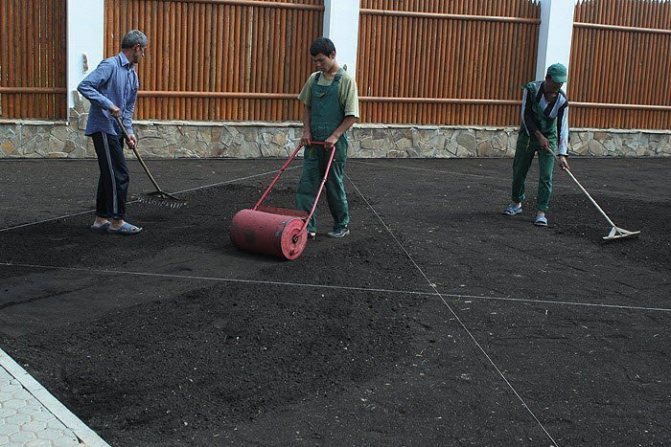

In the fall, you can devote your free time to the arrangement of green covering, and nature will help you with this. The land is already waiting for winter crops, autumn rains will provide watering, and the first frosts will protect young grass from weed aggression. Therefore, answering the question "How to plant a lawn?", One can say with confidence: "Autumn!"
Regular watering is the key to a beautiful lawn
A beautiful lawn will be on your site only if the soil on which the lawn grass grows, will be constantly hydrated... Drying of the soil should be avoided. Water the green lawn regularly. This should be done every day. If you skip watering, this will lead to drying out of the soil, which will negatively affect the future lawn - some young shoots will not sprout, and you will have to overseed. When watering, you need to know when to stop. In depth, the soil should be moistened by 10 cm, while there should be no puddles on the site.
Landscaping experts recommend sowing lawn grass until October 15... In this case, you can count on a quick entry of crops of grass. Shoots will sprout well and freezing in winter will be excluded. With the beginning of the spring period, they will continue their development and after a while will turn into a beautiful lawn.
It is desirable to calculate the autumn sowing of lawn grass so that it gains a height of at least 10 cm before frost.This point should be taken into account when mowing lawns. The last time it should be held at the end of October. After that, all the remnants of the cut grass are removed, and with them the fallen leaves and branches. A garden rake is used to remove them from the lawn.
If clay soil prevails at your summer cottage, and after each rain the water stagnates, then it is necessary to aerate the area in which your lawn grows. For this, the soil is dug to a depth of 10-20 cm in dry weather... The easiest way to do this is using a garden pitchfork. By performing this activity, the water will be diverted into the deep layers of the soil, and the roots will receive a breath of air, which will be reflected in the improved growth of the lawn grass.
The young lawn that appears on your site must be mowed before the first frost. This should be done immediately after the seedlings turn green. If you sowed lawn grass in the first weeks of September, then before the cold snap the grass will be 10 cm high. This is just what you need. In this case, you do not need to trim. Everything is limited to the usual trimming of the ends.
Key stages of care
- Watering. Seedlings will need two or three waterings per month. Sprinkler systems with suitable sprinklers are used: immature seedlings can be knocked out of the soil.
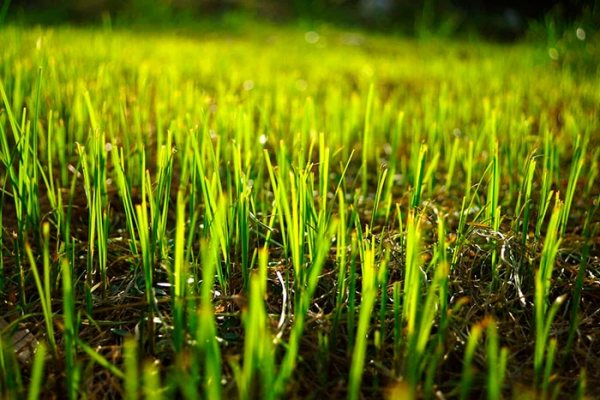

- A haircut. Autumn grass cutting - a push for forcing new stems, stimulating root growth. The last haircut is carried out 15–20 days before the expected frost. It is impossible to leave the grass uncut: "felt" prevents germination in spring.
- Cleaning. After cutting, they are passed with a fan rake. The cut grass clogs and makes it difficult to aerate. In case of difficult air exchange, the layer of "felt" provokes rotting of the roots.
- Fertilizer. Fertilizers of the potassium-phosphorus group are introduced. Terms of introduction - until October.
- Aeration. Working with a fan rake, pitchfork - piercing the turf, caked grass, to a depth of 8 cm to exclude rotting, stagnation of water, and improve air exchange.
Attention! The last mowing is carried out when the grass of the lawn rises to 6-8 cm.
How to sow lawn grass in the fall?
In principle, sowing a lawn is not such a difficult task, but it will require precision and accuracy from you.
First of all, we prepare auxiliary means, that is, in order not to leave marks on the ground, it is necessary to find two boards, but for this purpose you can also use wide skis.
If possible, we also use a special seeder, which will make it possible to distribute the seeds more evenly. ... You may also need a hand roller (to press the seeds into the soil) and a watering device.
To determine the amount of consumed seeds, the following conditions are taken into account:
- Seasonality. When sowing seeds in autumn, in comparison with spring sowing, the amount of used planting material is two times less. Due to this, the forming plants will be larger and stronger, therefore they will be better prepared for frost.
- The germination capacity of lawn grass seeds can persist for a long time, and it may take you more than one year to get a beautiful lawn.
- Before planting, you should also not forget about the additional introduction of mineral fertilizers into the soil containing a large amount of nitrogen. On average, one hundred square meters can take about 1.5 kilograms of fertilizers.
- With manual sowing, the seeds are divided into two equal parts and sown in two steps, in two mutually perpendicular directions.
- Proper watering is also important when planting lawn grass. Watering is carried out by sprinkling, while achieving a uniform distribution of moisture to a depth of at least 10 cm. It is also necessary to ensure that water does not stagnate on the soil surface.
Lawn development and soil preparation
Presowing work includes the following stages:
- One of the problems with lawns is weeds and perennials.They need to be destroyed before sowing the lawn, otherwise it will be very difficult to deal with them further.
- If time is not running out, it is worth treating the area several times with herbicides and digging up the weeds.
- Next, you need to loosen the ground and wait for the appearance of new weeds, and then re-treat everything with herbicides.
- Once you get rid of the weeds, dig up and treat the soil with a special compound.
- If a site after construction is used for planting a lawn, it is necessary to additionally clear the land of debris.
- If the top layer of soil was removed during construction, fill it with normal soil. If a lawn is placed on the site of the garden, additional work will not be required.
- With heavy clay soil, it is worth adding river sand to the ground, with acidic soil - add lime, with excessively chalky soil - peat. Compost (completely rotted) or vermicompost can be used as organic fertilizers. These fertilizers are cheap, but not overused. With compost, there is a risk of bringing weed seeds and pest larvae onto the lawn - with humus.
- After fertilization, the soil must be leveled with a special rake. In order for the grass to sprout evenly, the grains of soil should not be larger than a wheat grain.
- Further, the soil is compacted using boards or a roller. If everything is ready, you can sow the lawn grass.
Grooming and haircut
Autumn crops do not require special care, unless the autumn will be stingy with rains and then you will have to water the seedlings several times. With spring, and even more so summer crops, systematic watering is simply necessary. Otherwise, wait until the lawn turns green for a long time, and the young, immature grass that appears can dry out under the scorching rays of the June sun.
The autumn lawn in the country grows amicably and, having reached 10-12 centimeters, needs the first mowing. At this time, the grass cover is still not thick and dense enough, but it is a regular haircut that will improve these indicators. Cutting off the upper part stimulates the development of the root system and the forcing of new stems. So the coverage becomes denser with each subsequent haircut.


What is the best way to mow your lawn?
The modern market for garden tools offers many different mechanisms and equipment for lawn care. The most common: trimmer, electric lawn mowers (battery powered), gasoline lawn mowers, or lawn shears. What is better to choose depends on the amount of work to be done and, of course, on financial capabilities. With a trimmer, it is easy to process areas in the yard, near the house, cut the grass on the paths and around buildings. Lawn mowers are purchased for mowing lawns of large areas or grass on sports fields. Lawn scissors are useful for cutting grass in difficult areas: near flowerpots, swings, garden benches, as well as around tree trunks or bushes. From where and how the lawn is arranged in the country, what size it is and what kind of landscape, and the most suitable tools are selected.


The first shortening of the grass is carried out before frost, usually this is enough, and the work is left until spring. And in April, as soon as the snow melts, a green lawn will be waiting for you! But remember that after you have planted the lawn in the country, you only have to water, if necessary, fertilize 1-2 times per season, and most importantly, in no case do you allow the grass to overgrow.
When next summer your site is surrounded by a gorgeous lawn, you will have to prove to your neighbors and friends that you have grown such beauty yourself!
What kind of herb is best to use
You can immediately choose ready-made herbal mixtures in a garden store. These mixtures include:
- sports - suitable for landing on a football field;
- universal - suitable for any lawn, but require frequent mowing;
- frost-resistant - used for planting in cold regions;
- elite - they require certain conditions of detention, but they look very stylish;
- meadow - these varieties will make a small meadow out of the lawn with various blotches of flowers.
For the Russian climate, you can choose not mixtures, but individual herbs that will look great on a house or summer cottage.
Bluegrass
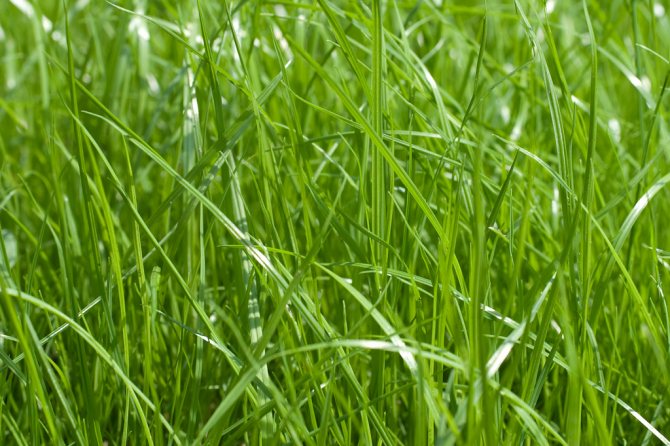

Bluegrass is a perennial herb that is used as a base for the mixture. The grass is easy to care for and has good germination.
Polevitsa
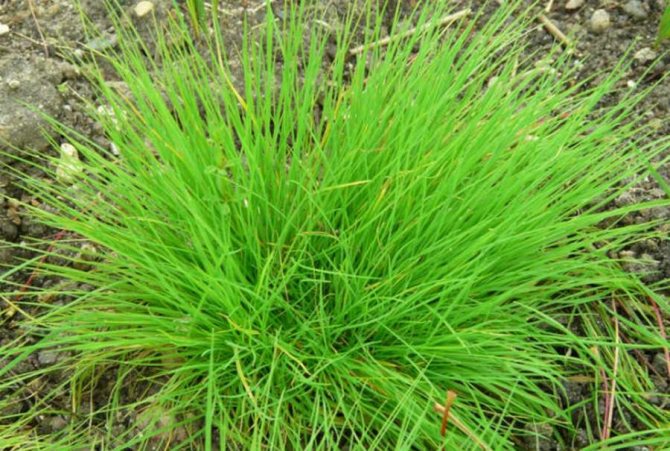

The grass of this variety grows densely and leaves no empty spaces on the lawn. The bent-grass has a rich green color, resistant to frost and frequent haircuts.
Ryegrass
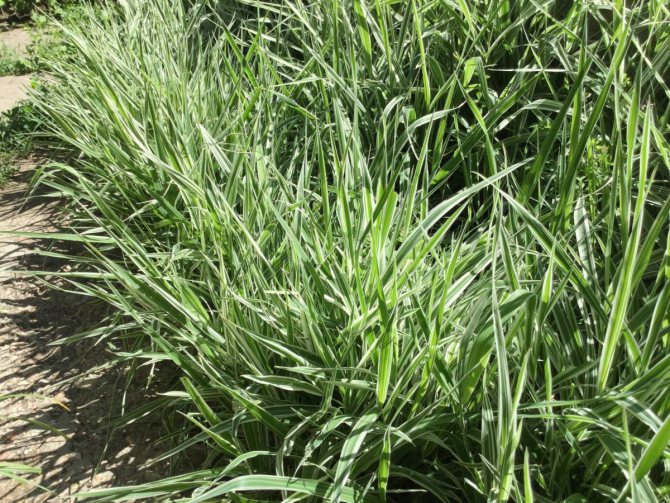

This herb goes well with cereals. Despite the fact that with the help of ryegrass you can create an excellent decorative lawn, it does not tolerate frost, therefore it is mainly used in the southern regions. The variety does not need a haircut, it is often found in the composition of elite grass mixtures.
Features of planting greenery on the lawn in spring and autumn
Having decided on the question of when to sow grass on the lawn, you should plan its shape and location. The rectangular shape of the lawn, which has clearly defined corners, will look the most advantageous. The disadvantages of this form are associated with the need for regular maintenance, which allows you to maintain the lawn in good condition.
If there is no time to carefully care for a plot with grass in the country, then the owner of the plot can use a simpler option, which involves choosing a shape that has slightly blurred boundaries. is possible only if there is high-quality drainage in an area where normal lighting is provided and there is no shade.
Having chosen the most suitable place, they begin to prepare the land for sowing plants. If you start preparing a plot for a lawn in the fall, then you can solve the problem not only with weeds, but also treat the soil with herbicides in advance. The earth is dug up and nitrogen-containing fertilizers are introduced into it.
The highest quality and thickest lawn grass is obtained, the planting of which was carried out in spring or autumn, since in the summer months there is a high probability of drought - the seeds may not sprout, and it is more difficult for plants to take root in such conditions. You can sow the grass in the second decade of May, having previously prepared the soil for the lawn, but still planting the lawn in the fall will be the most optimal.
Basic lawn care before winter starts
In order for the lawn to look perfect, in order to protect the plants during the unfavorable season for them, and in order to reduce the hassle in the spring, certain measures must be taken in the fall, including sowing fresh lawn grass, if required.
The works are carried out in September - the first half of October, before the first frost.
Watering
As a rule, in the fall, both Moorish and rolled lawns do not need regular watering, it usually rains at this time of the year. But in those cases when, for example, in September dry weather lasts for a long time, it is enough to water the lawn by sprinkling about once a week.
Watering the rolled lawn
In this case, the formation of puddles is unacceptable. In October, it is advisable to stop watering in order to avoid waterlogging of the soil due to which the grass can weaken and get sick, and this also applies to issues of caring for park roses.
Mowing grass
By the end of summer and the beginning of autumn, the lawn is cut less and less - the temperature drops, the ground cools down, and the plants begin to slow down.
But you should not completely stop mowing the lawn, because the overgrown grass will dry out with the onset of cold, lie on the ground and in the spring will become an obstacle to the emergence of new green shoots. Therefore, the lawn is mowed for the winter.
The last haircut is recommended to be done two weeks before frost
allowing the plants to grow to an optimal height of 6-8 cm.But since it is not always possible to predict the weather, it is best to mow the lawn as it grows, leaving at least 5 cm so that the grass does not spend all its energy on recovery and can save accumulated nutrients for future wintering. After cutting, it is necessary to clear the lawn of mowed grass and fallen leaves with the help of a fan rake that well lifts the newly mowed lawn. This is done so that the grass cover does not fade under them, and so that in winter the layer of "felt" does not impede air exchange in the grass root system, which can lead to plant rotting.
In addition, high humidity after heavy autumn rains can lead to the development of not only rot on the lawn, but also various diseases. The cut grass and the collected leaves can be laid on the empty beds to form humus for the next season, which can be quite useful for feeding roses in spring.
Top dressing
Mowing your lawn regularly keeps it looking well-groomed, but also drains the soil. She quickly loses potassium, nitrogen, phosphorus, due to the absence of which the grass cover begins to wither, thin out, turn pale. This also applies to the process of growing polyanthus roses from seeds.
Therefore, the autumn application of a strictly dosed amount of fertilizers (information on the dosage is contained on the package) is the same necessary and important procedure as other agrotechnical measures aimed at maintaining the decorative and aesthetics of lawns.
Nitrogen fertilizers:
- contribute to its growth;
- make the grass cover dense, dense, juicy green.
BUT! It should be remembered that it is impossible to apply nitrogen fertilizers to the landscape lawn in the autumn-winter period, since it is extremely undesirable for the grass to actively grow at this time.
Phosphate fertilizers:
- stimulate the autumn growth of lateral shoots;
- help lawn plants to endure the winter easier.
Phosphate fertilizers such as superphosphate or bone meal are applied once a year (spring / fall).
Potash fertilizers:
- strengthens plants and promotes the growth of rose flowers;
- make them resistant to disease, frost and drought;
- help to maintain color.
Lawn fertilization rules
- Fertilization is required strictly in accordance with the rules for caring for an ornamental lawn. Their number cannot be exceeded.
- It is necessary to evenly distribute the dressing over the entire surface of the lawn.
- You cannot use organic or complex mineral fertilizers from dubious manufacturers.
- Pay attention to the weather forecast: it is advisable that it rains after feeding.
- During rain, drought, frost, it is impossible to fertilize the lawn.
- Apply fertilizer to wet soil, but the grass itself must be dry to avoid burns.
- If there is no rain for two or more days after feeding, it is necessary to water the lawn with a hose so that the minerals can be absorbed into the soil.
Soil aeration
Aeration is the usual piercing of the turf with a garden pitchfork.
, but despite all its simplicity, it is a very effective procedure. Its purpose is to ensure that after the autumn cold rains, water can freely penetrate into deeper layers of the soil, and not freeze with an ice crust on the surface (i.e. drainage), as well as ensure the best air exchange between the grass root system and the environment.
The top layer of the soil over the summer, as a result of watering, drought, trampling and other factors, is strongly compacted, as a result of which excess carbon dioxide is formed in the soil. It makes it difficult for the lawn to grow and stops it completely. It is best to carry out this procedure in dry sunny weather in September. In addition to the pitchfork, special garden aeration devices are used to pierce the soil.
The depth of aeration is at least 8 cm.
Repairs
But in the fall, it would be good to align the pits on the surface of the lawn. To do this, you need sand mixed with leaf humus.The mixture is poured and tamped immediately. The bumps formed on the lawn are also very simple to fix: you need to cut off the top layer, remove excess soil from it and put the turf in place, after which you should also lightly tamp the soil.
How to grow a lawn in the country - from choosing seeds to sowing
The success of the work depends on many factors, but by observing the sequence of the process and adhering to the basic rules, you will definitely achieve excellent results. Usually, work can start from the end of August to the end of September, depending on climatic and weather conditions. Before sowing seeds, you need to prepare a plot of allocated land, stock up on tools, seeds and fertilizers.


Useful for work: shovel or pitchfork, comfortable rake, cultivator or flat cutter, watering can or hose with sprinkler attachment, wide boards and gloves.
We buy seeds... The answer to the question "How to plant a lawn correctly?" starts with choosing the right seed variety. Types of herbs and their mixtures should be purchased depending on the purpose of the future coating. On this basis, all commercially available seeds are divided: for a decorative or sports lawn. Ornamental, in turn, are divided into parterre (very dense and undersized grass) and garden and park (dense silky crops). The first option is suitable for sowing in large areas, which will be the backdrop for single elite plants, magnificent pavilions and fountains. Garden and park or ordinary lawns are characterized by soft and durable grass, durability and the ability to quickly recover. It was these qualities that influenced their popularity. Therefore, before you arrange a lawn in the country, purchase just such seeds.
Sports turf grasses are particularly durable. Strong grass cover is resistant to mechanical damage and to any weather changes - from summer heat to winter frost.
We stock up on fertilizers and other means... In addition to special lawn mixtures, fertilizers can be used: rotted manure, compost, and infusion of bird droppings, and humus, and mineral fertilizers. Usually, some of the fertilizer is applied before sowing, and the rest is used to maintain the growing lawn.
Depending on the type of soil and the water table, it may be necessary to add peat or sand to the soil, so consider this point as well.
To avoid weed control at least initially, it is recommended to use herbicides. Which specific product should be purchased depends on the weeds growing in your area, taking into account their perennial and annual species.


Armed with everything you need, you can get to work.
- We clear the soil from foreign objects. It pulls out growing weeds along with the roots, we select large stones, gravel, branches and other large debris. After all, the green country lawn is the place where your children will play in the summer, and its silk grass will beckon to walk barefoot.
- We stock up on tools and raw materials.
- If the land is worn out by previous plantings or this area is freed from old buildings, then it will be useful to apply fertilizer. After that, leave the area for some time (from two to four weeks) so that the soil "accepts" the applied fertilizers, and the nutrients are evenly distributed. Moisturizing the soil will help speed up this process, especially if the weather is dry.
- We loosen the earth. Deep digging is not required here, it is enough to fluff the top layer. If you are making a lawn in the country with your own hands, then it is better to use a pitchfork or a flat cutter for this. After that, we carefully level everything with a wide rake.
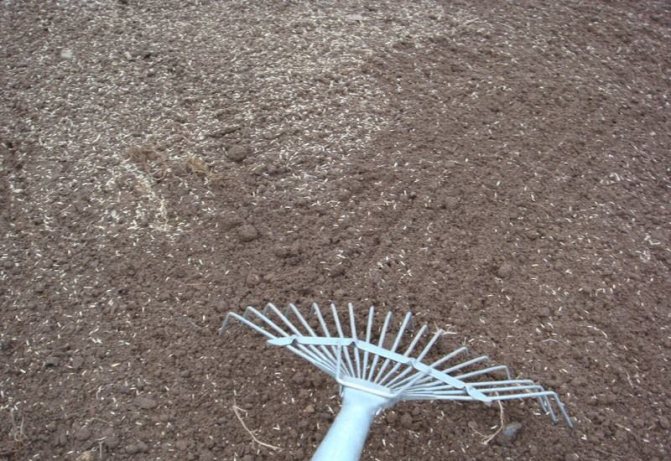

- Now the area needs to be compacted so that the seeds are distributed as evenly as possible. This can be done simply by trampling the ground. At this stage, do not rush, try to walk the entire area evenly, without making strong indentations and without leaving gaps.Of course, it is much faster and more efficient to compact with a hand roller, but not everyone has one on the farm, and in small areas, you can do without equipment. And before you make a large lawn at the dacha, a home football field or you have a plot with a complex landscape, it is better to buy a skating rink or borrow it from friends for a while.
- We lightly "pass" the finished surface with a rake and begin to sow grass. To trample the ground less, use prepared planks. Laying them alternately in front of you and stepping over them, you will pass the entire area, maintaining a flat surface and not trampling the seeds.
Advice! To make the seeds lay down more evenly, sow the area, passing it first along and then across. This will result in fewer gaps and the grass will grow with the same density.
- Now we apply mineral fertilizers. You can use special mixtures for lawns or conventional mixtures containing nitrogen, potassium and phosphorus. If the fertilizers are in granules, then it is enough to scatter them over the surface of the site, following the norms specified in the instructions. And liquid fertilizer solutions are added to the water during irrigation. Experts advise adding bone meal as fertilizer - it breaks down gradually, providing lawn grasses with food for several years.
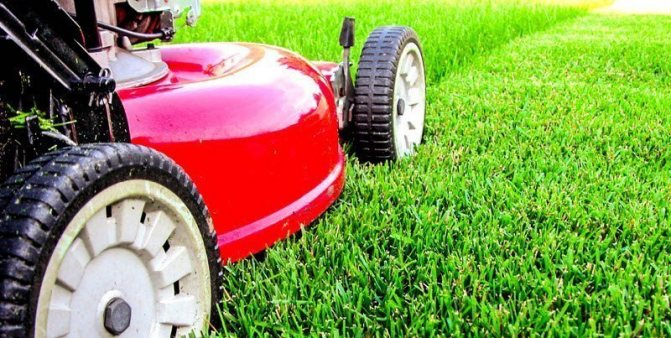

- Next, it is necessary to press the seeds to the ground so that they are not blown up by the wind, but at the same time they cannot be buried. Small grass seeds, covered with soil poorly, sprout for a long time and unevenly, which is why the lawn will look sloppy at first.
- All that remains is to water. A small area is watered using a regular watering can, but it is still more convenient to use an irrigation system with a sprinkler head or sprinklers. So the soil is less washed out and more evenly saturated.
The planting of the lawn at the dacha is over, then it remains only to wait for the shoots and rejoice, anticipating the bright green lawn in the yard.
Types of lawns and lawns
Lawns by the method of the device are divided into the following types:
- Artificial... It does not need to be sown, mowed, watered, fertilized. It will delight you with bright greenery in winter and summer. Still, this is more of a "cinematic" version.
- Roll... Such a lawn is a real outlet for business people. You can get a beautiful lawn quickly - in one day. The only preliminary work is leveling the ground.
- Seeded... He is the most troublesome. But this is the cheapest option. The main thing is to choose the right species composition of herbs, observe the planting technology and not be mistaken with the time of sowing seeds.
Lawn grass selection
When choosing grass for your lawn, it is important to consider whether a particular grass grows in your area. In many regions of the country, unadapted varieties can freeze.
The assortment in stores is very large, so you mainly need to focus on the manufacturer. For our area, universal grass mixtures are well suited for lawns.
Do not buy seeds at a discount - they may be nearing their expiration date.
Pay attention to the integrity of the packaging: damp seeds can rot
Recommendations
- The soil is not watered until the seeds are planted. They threaten to stick together, and the seedlings will be uneven.
- Overdosing on fertilizers will cause the grass to turn yellow.
- Watering and cutting are carried out at intervals of 21 days.
Lawn grass, like all garden plantings, must be fed during the entire summer season. From the end of summer it is necessary to limit (and gradually exclude from the "diet") the use of nitrogen-containing drugs. This chemical element (as well as its compounds) reduces frost resistance. But supplements based on phosphorus and potassium are just right. For example, superphosphate, wood ash, humus.
Regardless of the period chosen for planting, you should focus on calm weather. Or put an artificial fence on a segment of the territory where the "green carpet" is organized.Lawn grass seeds are so light (and sowing involves scattering them over the area) that just a slight gust is enough for them to migrate to another place. Consequently, we are no longer talking about the formation of the lawn as such. The grass will sprout anywhere, chaotically. You shouldn't forget about this.
Winter sowing has its pros and cons
The plus is the fact that the seeds become stronger with the cold. When the snow melts, moisture is formed, which is necessary for successful growth, the earth has time to rest. The grass that is planted in this crop is much more heat-resistant. At this time, there are no pests that could interfere with the growth of the grass.
The disadvantage of this sowing is the fact that the planted seeds can hatch ahead of time and die from the onset of cold weather. This can happen if the weather is warm for a long time in autumn or if warming alternates with cold snaps in spring. In addition, the seeds can wash away the melt water, resulting in bald spots. Thus, for the November sowing, the number of seeds must be increased. If the site has a steep slope, then it should not be done before winter, since the melt water will wash off the seeds with the top layer of the earth.
Back to the table of contents
Workshop: planting correctly
Planting grass in autumn is no different from spring-summer simplicity. The sequence of actions is as follows:
- The soil is prepared in July and August. The grooves are leveled with sand and humus: they are covered with a mixture and tamped. The hillocks are cut off: the towering soil is removed, light sod is laid out, and compacted.
- 10-14 days before planting the grass, fertilizer is applied for any lawn grasses, NPK complex with dominant potassium and phosphorus.
- After refueling, the soil is leveled with a rake or a cultivator to a depth of 14-15 cm, which contributes to both easy incorporation of fertilizer and leveling the lawn. After all the work, the soil should rest for a month.
- With the manual method, on a windless day, the grass mixture is scattered around the perimeter, then crosswise. For greater uniformity at the end of sowing, seeds are scattered in a fan-like manner over the entire area.
- Close up of seeds with a rake. Mulch with a layer of peat, which will serve as a warming and nutritious mulch, prevent leaching in spring.


Planting grass on the lawn - They are passed by a roller for the lawn - they are rolled in for planting so that the seeds are not blown away by the wind, pecked by birds.
- Watering the grass is carried out by sprinkling.
- The soil is prepared in July and August. The grooves are leveled with sand and humus: they are covered with a mixture and tamped. The hillocks are cut off: the towering soil is removed, light sod is laid out, and compacted.
- 10-14 days before planting the grass, fertilizer is applied for any lawn grasses, NPK complex with dominant potassium and phosphorus.
- After refueling, the soil is leveled with a rake or a cultivator to a depth of 14-15 cm, which contributes to both easy incorporation of fertilizer and leveling the lawn. After all the work, the soil should rest for a month.
- With the manual method, on a windless day, the grass mixture is scattered around the perimeter, then crosswise. For greater uniformity at the end of sowing, seeds are scattered in a fan-like manner over the entire area.
- Close up of seeds with a rake. Mulch with a layer of peat, which will serve as a warming and nutritious mulch, prevent leaching in spring.
Planting grass on the lawn - They are passed by a roller for the lawn - they are rolled in for planting so that the seeds are not blown away by the wind, pecked by birds.
- Watering the grass is carried out by sprinkling.
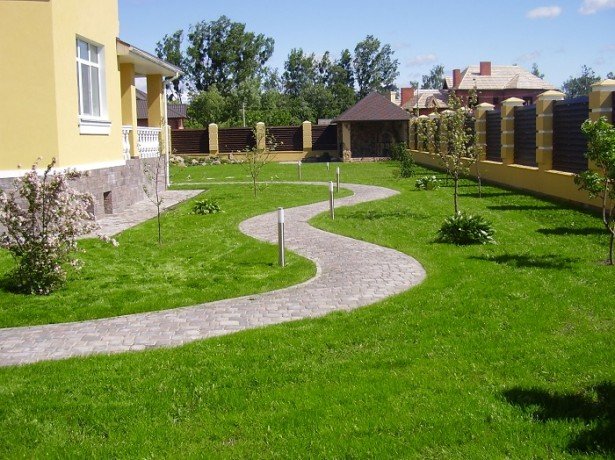

Sowing the seeds of the grass mixture in late August or September
In addition, planting lawn grass in the fall is convenient for those whose lawn area is not yet ready for the spring. A lot of time will pass while you free the area from excess debris, tamp and level the soil according to all the rules. But it is advisable to leave the land to rest for at least a month before sowing anything on it.
Video about lawn grass, when to plant a lawn in the country, how to do it correctly
Typically, a lawn mixture contains several different types of grasses, but all have approximately the same air temperature and humidity requirements. Therefore, choosing the time for sowing seeds should be based on the general rule: at least 40 days should remain before frost. It will take approximately this time for the seeds to sprout, the plants reach a sufficient height, and the root system gets stronger.
We suggest you familiarize yourself with: Lawn from A to Z. Creating the perfect green carpet
In central Russia, sowing lawn grass in the fall should be completed by September 10, at the most until September 25. At a later date, the plants do not have time to grow and freeze slightly.


The time for sowing seeds should be chosen based on the general rule: at least 40 days should remain before frost
How is the lawn sown in the fall:
- from the summer, prepare the soil on the site by carefully leveling it and tamping it;
- a week before sowing, scatter a complex fertilizer with a predominance of nitrogen over the ground;
- level the soil with a rake;
- on a calm day, sow the seeds first along the plot, then across, scattering them manually in a fan so that the seeds evenly fall on the ground;
- lightly cover the sown seeds in the soil with a rake;
- sprinkle on top with a thin layer of peat and walk with a roller for the lawn, otherwise the seeds will be blown away by the wind;
- water the lawn using the sprinkler method.


Since it rains quite often in the fall, there is no need for regular watering. Watering is necessary only during dry periods.
How the autumn planting of the lawn takes place, the video will help you better understand - open the tab to the article and see how quickly and easily everything is actually done.
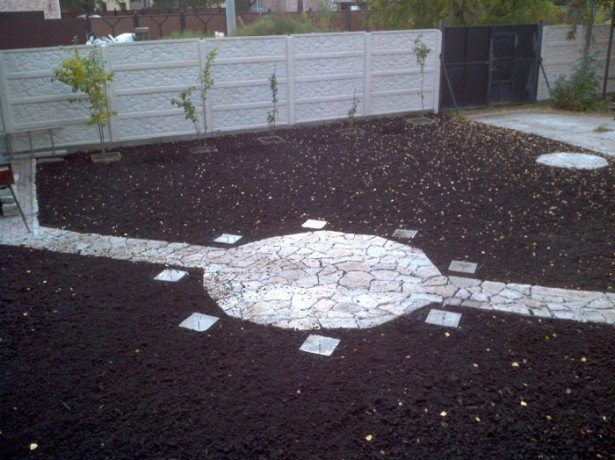

Since it rains quite often in the fall, there is no need for regular watering.
Why is it better to sow in autumn?
In the autumn months, the air is quite humid, while the temperature is moderate. That is, there are almost optimal conditions for the emergence of lawn grass. There is one more positive point about the autumn planting of the lawn - weeds grow worse... All of these factors contribute to:
- fast shoot formation;
- the formation of a stable root system of plants.
After a while, the owner will be able to get a beautiful lawn on his site.
If you sow the seeds of the grass mixture at the end of August or September, then you can get a beautiful lawn up to 10 cm high before the first autumn frosts. In order to grow a beautiful lawn the first time, it is necessary to carry out work to prepare the site on which the lawn grass will be planted.
Planting methods
Spreading seeds by hand does not produce even seeding. On a small area, a seeder will help - manual and mechanical, with the ability to regulate the material discharge. On large areas, the hydroseeding method is used. A composition is created that includes components for maintaining moisture, feeding the grass mixture, protecting against blowing:
- hydrogel that maintains soil moisture;
- fertilizers;
- colored mulch to visually level the grass.
Hydro-seeding is carried out using a hydraulic seeder - you can see how it is done in the photo. The method is indispensable for large areas and areas with a slope. The seedlings driven into the soil under a pressure of 6 A with a nutrient composition are not afraid of melt water.
Advice. The norm for autumn sowing and not only - up to 50 g of grass mixture per m2 with the manual method. With mechanized sowing, the consumption is up to 3 kg per 1 hundred square meters, i.e. 30 g per m2.



